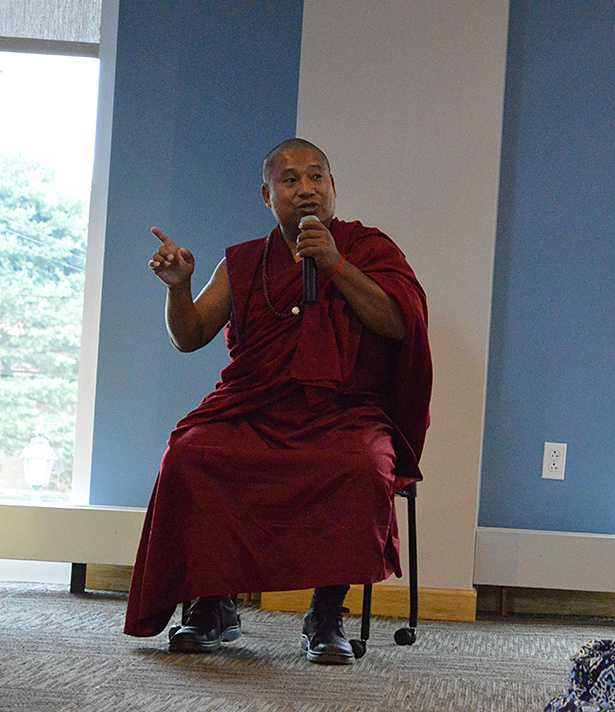Monks Teach About Life
Faculty, students, staff and residents of the region enthusiastically turned out to learn about the culture and philosophy of Tibetan monks from the Gaden Shartse Phukhang Monastery in India.
The Gaden Shartse Monastic College is at the forefront of the revival of Tibetan monastic education, with more than 1,600 resident students, teachers, scholars, and spiritual practitioners. More than 70 percent of members are between the ages of 10 and 25, and 80 percent were born in Tibet.
Many events held Oct. 5 to 9 were free to the public, and they included lectures, a musical program, ceremonial prayers and chanting, and the creation and destruction of a sand mandala in the Pauly Friedman Art Gallery.
The monks began to create their sand mandala just after opening ceremonies and worked on it until the evening when they presented a Golden Tea Offering, a ceremony of prayers and chanting.
They continued their painstaking work until the evening of the next day, when they performed a Tara Puja, a 50-minute musical program.
The monks continued the sand work until closing ceremony Oct. 9, when they dissolved the sand mandala as a way to show the impermanence of life. According to Buddhist scripture, sand mandalas transmit positive and healing energies to people who view them. Monks will disperse some of the sand into flowing water, which will carry it to the ocean, which in turn will spread it around the world for planetary healing.
As part of their visit, the Tibetan monks also lectured in multiple classes. He said the experience provides many valuable additions to his course content.
“First of all, the cultural sharing we can gain from this, and how important it is to understand the methodology, thinking, philosophy and religious
experience of people dedicated to a completely different form of religion than we are used to understanding. They focus in on notions of compassion, forgiveness, priorities in life, and a sense of gaining enlightenment in our lives, and how we can become more enlightened, compassionate and peaceful people, which I feel will contribute a great deal to the overall culture of MU. At the same time, I’m hoping my students will gain appreciation for this particular form of religion, and even gain ways they can implement in their own lives some of the ideas and philosophy that bring about peace and compassion,” said Jacobs.
Students said they were curious about the monks’ philosophy and way of life.
“I think it would be nice to find out more about their beliefs and why they smash their artwork. It would be good for all of us to learn some new things,” said first year English major Kristen Capitano.
“I feel it will open the eyes of the students to see people destroy something they have put a lot of effort into,” said first year Christian San Pedro.
Likewise, freshman nursing major Paige Clancy said students can use the experience to expand their point of view.
“I think it’s always good to get different viewpoints and talk to people about their religion. I think we gain a lot from that as a school, as a community, and on a personal level,” said Clancy.
Some students, however, said they were unaware of the monks’ visit.
“I know nothing at all about the monks, and didn’t know they were coming here until very recently. I don’t plan on seeing them because I don’t know much about monks, but I think a lot of others will see them and be impacted by them,” said first year physical therapy major Patrick Demichele.
Dr. Joseph Curran, Associate Professor and Chair of Religious Studies, said he valued the monks’ sharing their prayer lives and teaching meditation, which can help everyone to live healthier lives.
“First of all, it’s one thing to study another religion, but it’s another thing to actually meet people who practice that religion and to talk to them. For students of our World Religions class, it’s one thing to read about a religion or hear and see pictures about it, but it’s much more effective to meet someone who actually practices that religion and to see them pray. For this reason, we arranged for some of the monks to lecture in various classes, and not just in religion classes.”
Curran added that the Monks’ visit also benefits the training of future monks.
“The country of Tibet used to be ruled by various different Buddhist monasteries, including the one headed by the Dalai Lama, and when communist China took over Tibet, many of those monasteries moved into India and were exiled there. The monks are trying to raise money to support the seminary where they train future monks. By coming here, they are sharing their tradition with us, but they are also trying to raise money for future monks to keep their monastic tradition alive,” said Curran.

